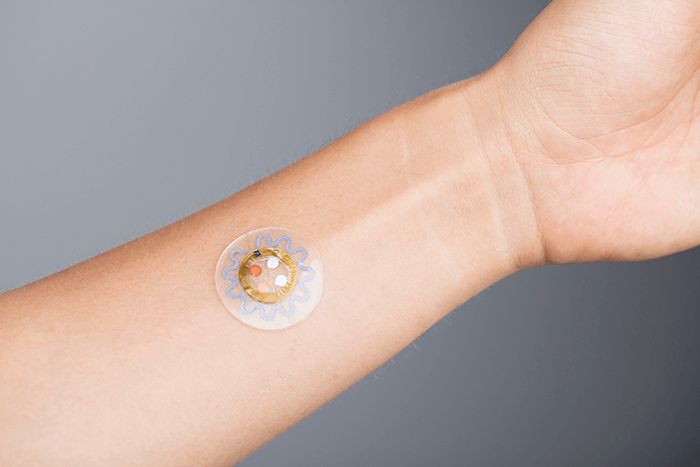
An eight hour fast, a pin prick, and a blood test. Standard procedure when testing for diabetes, but could the same diagnosis be made by wearing an epidermal patch instead? Researchers at Northwestern University are working towards making that a reality with their “lab on the skin” device which collects, stores, and analyzes sweat in real time (1). Why focus on sweat? John Rogers, Professor of Materials Science and Engineering at Northwestern University, explains, “Sweat is an interesting class of biofluid because it can be captured noninvasively. We were looking to work on a simple type of device capable of performing in situ chemical analysis of sweat, as well as analyzing sweat rates and total sweat loss.” Sweat contains an array of biomarkers, so the approach has potential as an alternative to invasive diagnostic tests.
The wearable epidermal device collects sweat through microchannels and displays pH, chloride, glucose, and lactate levels via colorimetric analysis. An embedded NFC coil allows the wearer to optionally connect their phone to the device with a simple tap, then take a photo of the device, enabling the phone to quantitively determine the status of each metric. “We’re focused first on fitness and sport, partly because the application requirements are relatively easy to meet. But we’re simultaneously exploring sweat glucose measurements with relation to diabetes patients, and sweat chloride measurements as an assessment of cystic fibrosis,” says Rogers. The team also suggest that the device could be modified to noninvasively test other bodily fluids, such as tears or saliva. The investigators previously developed a whole suite of electronic devices that interface with skin to perform clinical quality measurements. The latest device is an evolution of those projects – cheap, durable, and power-free, but with a stronger focus on fluidics and analysis. “In terms of technology, we’re taking the next steps in integrating fluidics with electronic/optoelectronic functions beyond what we’ve demonstrated with our ‘lab on the skin’ device,” concludes Rogers.
References
- A Koh et al., “A soft, wearable microfluidic device for the capture, storage, and colorimetric sensing of sweat”, Sci Transl Med, 8, 336ra165 (2016). PMID: 27881826.




